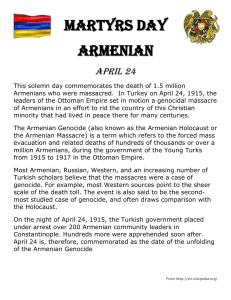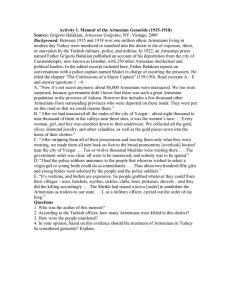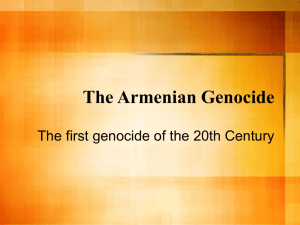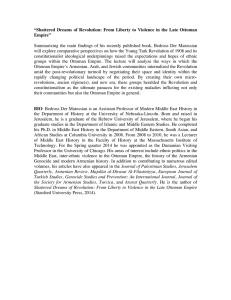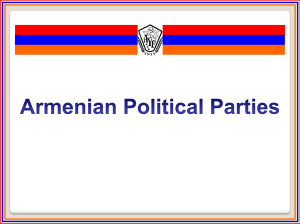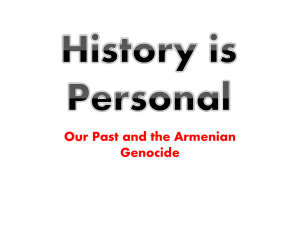They Can Live in the Desert but Nowhere Else
advertisement
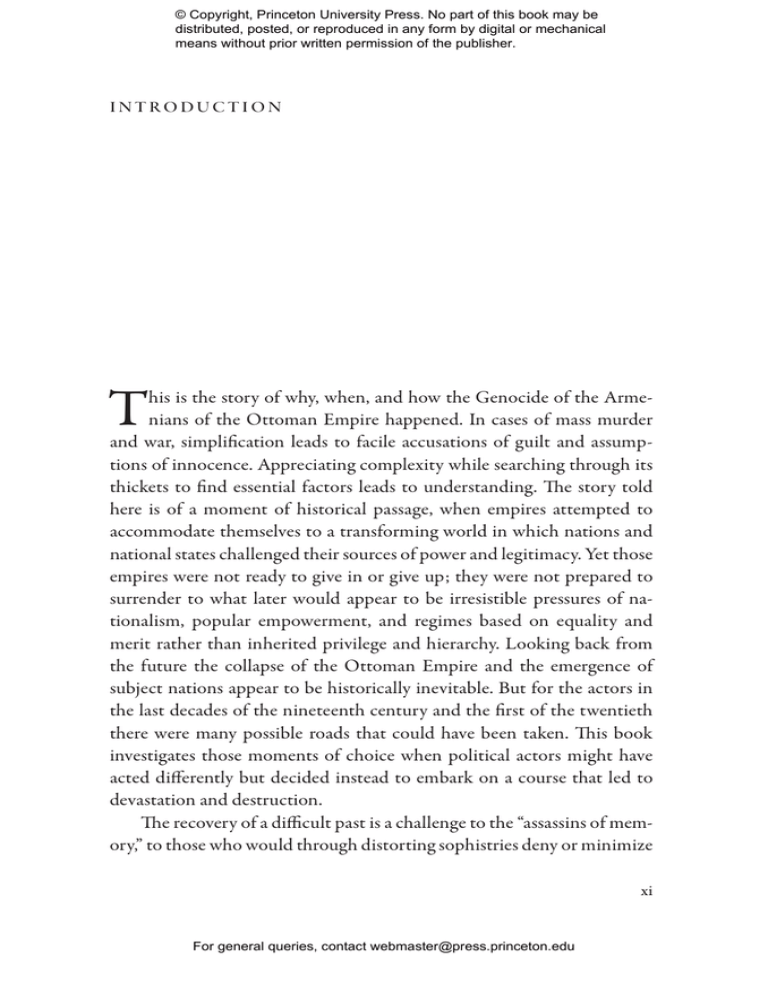
© Copyright, Princeton University Press. No part of this book may be distributed, posted, or reproduced in any form by digital or mechanical means without prior written permission of the publisher. I n t ro d u ct i o n T his is the story of why, when, and how the Genocide of the Armenians of the Ottoman Empire happened. In cases of mass murder and war, simplification leads to facile accusations of guilt and assumptions of innocence. Appreciating complexity while searching through its thickets to find essential factors leads to understanding. The story told here is of a moment of historical passage, when empires attempted to accommodate themselves to a transforming world in which nations and national states challenged their sources of power and legitimacy. Yet those empires were not ready to give in or give up; they were not prepared to surrender to what later would appear to be irresistible pressures of nationalism, popular empowerment, and regimes based on equality and merit rather than inherited privilege and hierarchy. Looking back from the future the collapse of the Ottoman Empire and the emergence of subject nations appear to be historically inevitable. But for the actors in the last decades of the nineteenth century and the first of the twentieth there were many possible roads that could have been taken. This book investigates those moments of choice when political actors might have acted differently but decided instead to embark on a course that led to devastation and destruction. The recovery of a difficult past is a challenge to the “assassins of memory,” to those who would through distorting sophistries deny or minimize xi For general queries, contact webmaster@press.princeton.edu xii © Copyright, Princeton University Press. No part of this book may be distributed, posted, or reproduced in any form by digital or mechanical means without prior written permission of the publisher. Introduction the enormity of a human tragedy.1 Nations and states have long been in the business of fabricating, sometimes more honestly than at other times, myths and stories of their origins, golden ages, heroic deeds, victories, and triumphs, while eliminating the blemishes of defeats and failures, even mass murders. What appears to be new in our own time is the brazenness of what is claimed, the blatant cynicism of the perpetrators, and their potential reach through mass print and broadcast media, film, and the internet. Historians inevitably have been pulled into this war of images and words. The only weapon against bad history deployed for political or personal vindication is scrupulous investigation that results in evidence-based narration and analysis of what it is possible to know. The proliferation of useable pasts and preferred realities is a challenge to historians. They can take some comfort in the thought that dangers lurk when intellectual constructs stray too far from careful and accurate readings of the world. Reality has a nasty habit of biting back. Revision of history is constant, even necessary, but in some cases, like that of the fate of the Armenians in the last years of the Ottoman Empire, it has led to the creation of two separate, contradictory narratives that appear to defy reconciliation. Although the literature produced by historians who favor the “Armenian” view and those who support the “Turkish” version actually agrees on many of the basic facts, for decades various authors have emphasized different elements and in general either avoided explanations of the causes of the events or implied an explanation even while not systematically or explicitly elaborating one. The Turkish state and those few historians who reject the notion of genocide have argued that the tragedy was the result of a reasonable and understandable response of a government to a rebellious and seditious population in time of war and mortal danger to the state’s survival. Raison d’état justified the suppression of rebellion, and mass killing was explained as the unfortunate residue (“collateral damage” in the now fashionable vocabulary) of legitimate efforts to establish order behind the lines. This position, which those who recognize the 1915 Genocide call denialist, might be summarized as follows. There was no genocide, and the Armenians were to blame for it. They were rebellious, seditious subjects who presented a danger to For general queries, contact webmaster@press.princeton.edu © Copyright, Princeton University Press. No part of this book may be distributed, posted, or reproduced in any form by digital or mechanical means without prior written permission of the publisher. Introduction the empire and got what they deserved.2 Relative peace and harmony had existed in the Ottoman Empire between the state and its religious minorities until outside agitators, usually from the Russian Empire, aroused the nationalist and separatist passions of the Armenians. Still—the denialists claim—despite the existential threat posed by the Armenians and their Russian allies to the survival of the empire, there was no intention or effort by the Young Turk regime to eliminate the Armenians as a people.3 On the other side, many historians sympathetic to the Armenians shied away from explanations that might place any responsibility at all on the victims of Turkish policies. Armenian writers and the majority of scholars defended the case that massive deportations and massacres were ordered by and carried out by the Young Turk authorities and that these events constituted the first major genocide of the twentieth century.4 Because a nuanced account of the background and causes of the Genocide seemed to concede ground to the deniers, Armenian scholars in particular were reluctant to see any rationale in the acts of the Young Turks.5 Explanation, it was claimed, is rationalization, and rationalization in turn leads to the denialist position of justification. When explanation was offered, it was either an essentialist argument—Turks are the kind of people who employ massacre and systematic killing to maintain their imperial dominance—or related arguments that religion and/or ethnicity were the underlying causes of the killings. Deep, indelible cultural characteristics lay at the bottom of many interpretations. The most insidious argument spoke of a conflict of two nationalist movements, Turkish and Armenian, over a single contested territory, eastern Anatolia.6 “For the Turks,” wrote the eminent Islamic historian Bernard Lewis, the Armenian movement was the deadliest of all threats. From the conquered lands of the Serbs, Bulgars, Albanians, and Greeks, they could, however reluctantly, withdraw, abandoning distant provinces and bringing the Imperial frontier nearer home. But the Armenians, stretching across Turkey-in-Asia from the Caucasian frontier to the Mediterranean coast, lay in the very heart For general queries, contact webmaster@press.princeton.edu xiii xiv © Copyright, Princeton University Press. No part of this book may be distributed, posted, or reproduced in any form by digital or mechanical means without prior written permission of the publisher. Introduction of the Turkish homeland—and to renounce these lands would have meant not the truncation, but the dissolution of the Turkish state. Turkish and Armenian villages, inextricably mixed, had for centuries lived in neighborly association. Now a desperate struggle between them began—a struggle between two nations for the possession of a single homeland, that ended with the terrible holocaust of 1915, when a million and a half Armenians perished.7 In what appeared to be a cool and balanced understanding of why their Ottoman rulers would have used mass violence against a perceived Armenian danger, Lewis placed the Armenians “nearer [the Turkish] home” and “in the very heart of the Turkish homeland,” employing language that already assumed the legitimacy and actuality of a Turkish nation-state. In this transparent paragraph Lewis subtly rewrote the history of Anatolia from a land in which Armenians and Kurds were the earlier inhabitants into one in which they become an obstacle to the national aspirations of the Turks, who now could claim Anatolia, rather than Central Asia, as their homeland. His language employed the logic of nationalism as if it had a kind of universal relevance even in political structures that evolved out of and still worked within the logic of empire. In 1915 the Ottoman Empire was evolving into a more homogeneous Turkic-Muslim state, in large part because of the loss of its Christian-­ populated territories in the Balkans. Yet it remained a multinational imperial state with large Arab, Kurdish, Jewish, and Christian communities. Already long existing within an international system of powerful nation-states in which an increasingly hegemonic Western conviction that the nation, however defined, was the principal source of political legitimacy, the Ottomans were desperately seeking a road to survival. But ­Lewis’s reading of a notion of ethnic homogeneity as the basis for a national republic of the Kemalist type, which lay in the future, into the moment of Armenian annihilation is ahistorical and anachronistic. The argument that I make in this book is different: whatever else they were, the Young Turks who carried out the Genocide were never purely Turkish ethnonationalists, never religious fanatics, but remained For general queries, contact webmaster@press.princeton.edu © Copyright, Princeton University Press. No part of this book may be distributed, posted, or reproduced in any form by digital or mechanical means without prior written permission of the publisher. Introduction Ottoman modernizers in their fundamental self-conception. They were primarily state imperialists, empire preservers, rather than the founders of an ethnic nation-state. There was no thought of giving up the Arab lands that they still controlled, or even eliminating totally their Christian and Jewish subjects, and when opportunity presented itself in 1918 the Young Turks were prepared to move north and east into Caucasia to create buffer states using other Muslim and Christian peoples. On the other hand, over time the Young Turks came to believe that Muslims, particularly Turks, were the appropriate people to rule the empire, that Muslims, particularly Turks, were the most trustworthy supporters of the Ottoman state, and increasingly convinced themselves that egalitarian Ottomanism was a political fantasy. Moreover, the removal of the Armenians, and later the Greeks, laid the basis for the Kemalist state, the current Turkish Republic, and many of the surviving Young Turks were among the founders of the republic. Kemal’s ethnonationalism attempted to create an ethnically homogeneous Turkish nation, though ultimately that ambition was thwarted by the millions of Kurds who had lived in eastern Anatolia long before the first Turks arrived and who after 1915 spread to lands formerly held by Armenians. In their ideal forms nation and empire stand at opposite ends of a political spectrum, but in the actuality of history they influenced, reinforced, and undermined one another at different times and in different ways. Nineteenth-century liberal states were able to compromise and collaborate with imperialism. Even though at home Great Britain, France, Belgium, and the Netherlands enjoyed representative institutions and styled themselves as democracies, they could be (and were) effective (and very often brutal) imperial powers in their overseas empires. “Civilization” in the homeland flourished in parallel with cruel and repressive exploitation of native peoples of Africa, Asia, and the Caribbean. Both the Russian and Ottoman Empires were instances of determined, haphazard, and ultimately futile attempts to modernize and nationalize the empire, to make it at some points more civilly unified and coherent, more Rossiiskii (inclusive of all the tsar’s subjects) or Osmanlı (Ottoman rather than ethnic Turkish), and at other points more ethnically homogeneous, For general queries, contact webmaster@press.princeton.edu xv xvi © Copyright, Princeton University Press. No part of this book may be distributed, posted, or reproduced in any form by digital or mechanical means without prior written permission of the publisher. Introduction more Russkii (ethnic Russian) or Türk (ethnic Turk). In neither case was there a clear or even feasible program of creating an ethnonational state like France or the Kemalist Turkish Republic; their projects are better characterized as the creation of “imperial nations” within their empires. The empire was to continue but in a new form appropriate for the modern age, what has been called the age of nationalism and nation-states, but more accurately should be referred to as the age of empires.8 A succession of modernizing efforts—the Western-oriented Ottoman state–­ promoted reforms known as the Tanzimat, the Hamidian Islamic coalition, and the Young Turks’ initial constitutionalism that degenerated into absolutism—­followed one another, and non-Turks struggled to find their own place within a tremulous political landscape. Because the eventual deportations and mass murder of Armenians and the expulsion of Greeks resulted in a relatively homogeneous population of Muslims (Turks, Kurds, Circassians, and others) and the foundation of a Turkish national republic, the history of the last stages of the Ottoman Empire has been subsumed into an organic nationalist narrative, which reads back the emergence of an original, authentic Turkish nation into earlier centuries. The unique moments of attempted imperial regeneration in the Tanzimat, Hamidian, and Young Turk periods have as a consequence been effaced. This book is dedicated to reconstructing those moments, which involved new national imaginings of the various peoples of the empire, efforts by state authorities to construct a new kind of empire, and ultimately the destruction of hundreds of thousands of Ottoman Armenians and Assyrians. In the past decade and a half, certainly since the turn of the twenty-­ first century, the historiography on the last years of the Ottoman Empire and the Armenian Genocide has made giant strides. The Workshop in Armenian-Turkish Studies (WATS), which first met in 2000 at the University of Chicago amid deep suspicion of the possibility of cooperation of Armenian, Turkish, and Kurdish scholars, pioneered discussion and collaborative work between social scientists of different nationalities and historical schools.9 Although new forms of denialism have also appeared, the work of Armenian, Turkish, Kurdish, European, and American ­scholars For general queries, contact webmaster@press.princeton.edu © Copyright, Princeton University Press. No part of this book may be distributed, posted, or reproduced in any form by digital or mechanical means without prior written permission of the publisher. Introduction has created a huge reservoir of documentary materials. A flood of archival documents changed the empirical understanding of what had happened in 1915 and why.10 Archivally based monographs and brilliantly conceived synthetic studies have made it possible for the first time to understand the Armenian Genocide.11 As the pioneering Turkish scholar of the Genocide Taner Akçam has summed up, “Taken in their entirety, Ottoman and Western archives jointly confirm that the ruling party CUP did deliberately implement a policy of ethnoreligious homogenization of Anatolia that aimed to destroy the Armenian population.”12 Scholars in Turkey, many of them veterans of WATS, courageously—and against the opposition of their government—held their own conference on “The Ottoman Armenians during the Era of Ottoman Decline” at Bilgi University in Istanbul in September 2005.13 The backlash against scholarship remained relentless.14 A principal participant in both WATS and the Bilgi conference, the fearless Turkish Armenian journalist Hrant Dink fell victim to the vicious nationalist attacks on those who championed understanding of the troubled history of these two peoples. On January 19, 2007, a young militant shot and killed him on an Istanbul avenue. There may be no escape from the political aspects of setting the rec­ ord straight on any genocide, and the Armenian Genocide more than most other mass killings has been the victim of deliberate, sustained falsification. Historians are embedded in those politics no matter how faithfully they attend to the obligations of their craft. As Turkey and Armenia both construct and reconstruct their historic and present-day identities, they have to deal with the traumas of their twentieth-century emergence. These two countries and their peoples, both at home and in the diaspora, are condemned to live in the present and the future side by side, as they have for half a millennium in the past, their destinies intertwined, their senses of self intimately wrapped up in the other. For historians, who have done so much to construct the pasts with which each nation now lives, the task of reconstruction has become imperative. In a humble way, this book is an effort to create a credible contribution to what honest scholars and journalists, like Hrant Dink, tried (and are trying) to do: tell the story of Armenians, Assyrians, Turks, and Kurds in all its aspects, tragic, For general queries, contact webmaster@press.princeton.edu xvii xviii © Copyright, Princeton University Press. No part of this book may be distributed, posted, or reproduced in any form by digital or mechanical means without prior written permission of the publisher. Introduction heroic, foolish, and well-intended, a story of how people attempted to make a better life for themselves within an empire that itself chose a path that led to the destruction of both the state and millions of its subjects. What Happened in 1915 Before turning to a comprehensive explanation of why the Genocide occurred, an excursion that will take us back into the long history of the Armenians and their experiences in the Ottoman Empire, we will look briefly at what happened in 1915. Some 2 million Christian Armenians lived in the Ottoman lands, most of them peasants and townspeople in the six provinces of eastern Anatolia. In an Anatolian population estimated to be between 15 and 17.5 million inhabitants, Armenians were outnumbered by their Muslim neighbors in most locations, though they often lived in homogeneous villages and sections of towns, and occasionally dominated larger rural and urban areas.15 The most influential and prosperous Armenians lived in the imperial capital, Istanbul (Constantinople), where their visibility made them the target of both official and popular resentment from many Muslims. What has come to be known as the first genocide of the twentieth century had its origins in the aspirations of a small group of Ottoman politicians associated with the Committee of Union and Progress (CUP), popularly referred to as the Young Turks.16 Both the radicalization of their intentions and the final implementation of their plans occurred in the context of a deepening social and political crisis and the near destruction of the Ottoman state at the hands of external enemies. Having suffered territorial losses in the Balkan Wars (1912–1913) and forced to accept a European-imposed reform in the Armenian provinces, the Young Turks joined the Central Powers—­ Germany and Austro-Hungary—in 1914 as they waged war against the Entente—Great Britain, France, and Russia—in a desperate effort to restore and strengthen their empire. Armenians precariously straddled the Russian-Ottoman front, and both the Russians and the Ottomans attempted to recruit Armenians in their campaigns against their enemies. Most Ottoman Armenians supported and even fought alongside the For general queries, contact webmaster@press.princeton.edu © Copyright, Princeton University Press. No part of this book may be distributed, posted, or reproduced in any form by digital or mechanical means without prior written permission of the publisher. Introduction ­Ottomans against the Russians, while Armenians in Russia, organized into volunteer units, joined the tsarist campaign. In late 1914 and early 1915 massacres of Christians—Armenians and Assyrians—and Muslims occurred in the Caucasus and Persia, where Russians and Ottoman forces faced each other. In early 1915 the Ottomans lost a major battle on the Caucasian front at Sarıkamış, and important Young Turks attributed the loss to Armenian treachery. In late February to early March 1915 the Young Turk government, led by Talat and Enver, ordered the disarming of Armenian soldiers and their transfer into labor battalions. The first victims of the state were the demobilized Armenian soldiers, who were easily segregated and systematically killed. Thus the muscle of the Armenian communities was removed. Almost immediately the government ordered the deportation of Armenians from cities, towns, and villages in the East, ostensibly as a necessary military measure to ensure the security of the rear. Soon Armenians throughout the country were forced to gather what belongings they could carry or transport and leave their homes at short notice. The exodus of Armenians was haphazard and brutal; irregular forces, local Kurds and Circassians, cut down hundreds of thousands of Christians, as civil and military officials oversaw and facilitated the removal of the empire’s Armenian and Assyrian subjects. When some Armenians resisted the encroaching massacres in the city of Van in eastern Anatolia, the Committee of Union and Progress had the leading intellectuals and politicians in Istanbul, several of them deputies to the Ottoman Parliament, arrested and sent from the city. Most of them perished in the next few months. Thus was the brain of the Ottoman Armenian people removed, the intellectual and political leadership and the connective tissue that linked separate communities together. Women, children, and old men in town after town were marched through the valleys and mountains of eastern Anatolia. Missionaries, diplomats, and foreign military officers witnessed the convoys, recorded what they saw, and sent reports home about death marches and killing fields. Survivors reached the deserts of Syria, where they languished in concentration camps; many starved to death, and new massacres occurred. For general queries, contact webmaster@press.princeton.edu xix xx © Copyright, Princeton University Press. No part of this book may be distributed, posted, or reproduced in any form by digital or mechanical means without prior written permission of the publisher. Introduction The causes of the Genocide were both long term and immediate. To understand what happened and why, I explore the lengthy historical trail of events and experiences, the genealogy of attitudes and behaviors. The environment in which Genocide occurred—the imperial appetites of the Great Powers, the fierce competition for land and goods in eastern Anatolia, the aspirations and aims of Armenians, and the ambitions and ideas of the Young Turks—shaped the cognitive and emotional state of the perpetrators (what I call their “affective disposition”) that allowed them, indeed in their minds required them, to eliminate whole peoples.17 In the context of war and invasion a mental and emotional universe developed that included perceived threats, the Manichaean construction of internal enemies, and a pervasive fear that triggered a deadly, pathological response to real and imagined immediate and future dangers. A government had come to believe that among its subject peoples whole “nations” presented an immediate threat to the security of the state. Defense of the empire and of the “Turkish nation” became the rationale for mass murder. Armenians were neither passive nor submissive victims, but the power to decide their fate was largely out of their hands. A “great inequality in agency” existed between Young Turks and their armed agents and the segmented and dispersed Armenians.18 The canvas on which the mass deportation and massacre of Armenians and Assyrians took place was a landscape that stretched from Istanbul almost 1,000 miles to the east, beyond the eastern ends of the Otto­ man Empire into Persia and the Caucasus. Mountains, valleys, rivers, and deserts were the topographies through which hundreds of thousands of uprooted people moved in convoys guarded by Ottoman soldiers and gendarmes, attacked and slaughtered by the çetes (gangs of irregular fi ­ ghters) of the Teşkilat-ı Mahsusa (Special Organization), by Kurds, Turks, and Circassians. Driven to exhaustion, starvation, and suicide, hundreds of thousands, perhaps a million or more, would perish; others would be forced to emigrate or convert to Islam to save their lives. Men died in greater numbers; many women and children were taken into the families of the local Muslims. Tens of thousands of orphans found some refuge in the protection of foreign missionaries. It is estimated c­ onservatively that For general queries, contact webmaster@press.princeton.edu © Copyright, Princeton University Press. No part of this book may be distributed, posted, or reproduced in any form by digital or mechanical means without prior written permission of the publisher. Introduction between 600,000 and 1 million were slaughtered or died on the marches. Other tens of thousands fled to the north, to the relative safety of the Russian Caucasus. Hundreds of thousands of women and children, we now know, were compelled to convert to Islam and survived in the families of Kurds, Turks, and Arabs. By the end of the war 90 percent of the Armenians of the Ottoman Empire were gone, a culture and civilization wiped out never to return. Those who observed the killings, as well as the Allied powers engaged in a war against the Ottomans, repeatedly claimed that they had never witnessed anything like it. The word for what happened had not yet been invented.19 There was no concept to mark the state-targeted killing of a designated ethnoreligious people. At the time those who needed a word borrowed from the Bible and called it “holocaust.” My great-grandparents were among the victims. For general queries, contact webmaster@press.princeton.edu xxi
